| CAS NO: | 850876-88-9 |
| 规格: | ≥98% |
| 包装 | 价格(元) |
| 5mg | 电议 |
| 10mg | 电议 |
| 25mg | 电议 |
| 50mg | 电议 |
| 100mg | 电议 |
| 250mg | 电议 |
| 500mg | 电议 |
| Molecular Weight (MW) | 731.83 |
|---|---|
| Formula | C35H46FN5O9S |
| CAS No. | 850876-88-9 |
| Storage | -20℃ for 3 years in powder form |
| -80℃ for 2 years in solvent | |
| Solubility (In vitro) | DMSO: 144 mg/mL (196.8 mM) |
| Water: <1 mg/mL | |
| Ethanol: 144 mg/mL (196.8 mM) | |
| Other info | Chemical Name: (2R,13aS,14aR,16aS,Z)-6-((tert-butoxycarbonyl)amino)-14a-((cyclopropylsulfonyl)carbamoyl)-5,16-dioxo-1,2,3,5,6,7,8,9,10,11,13a,14,14a,15,16,16a-hexadecahydrocyclopropa[e]pyrrolo[1,2-a][1,4]diazacyclopentadecin-2-yl 4-fluoroisoindoline-2-carboxylate InChi Key: ZVTDLPBHTSMEJZ-QIFYYAQYSA-N InChi Code: InChI=1S/C35H46FN5O9S/c1-34(2,3)50-32(45)37-27-13-8-6-4-5-7-11-22-17-35(22,31(44)39-51(47,48)24-14-15-24)38-29(42)28-16-23(19-41(28)30(27)43)49-33(46)40-18-21-10-9-12-26(36)25(21)20-40/h7,9-12,22-24,27-28H,4-6,8,13-20H2,1-3H3,(H,37,45)(H,38,42)(H,39,44)/b11-7-/t22-,23-,27?,28+,35-/m1/s1 SMILES Code: O=C(N1CC2=C(C(F)=CC=C2)C1)O[C@@H](C3)C[C@](C(N[C@@](C4)(C(NS(=O)(C5CC5)=O)=O)[C@]4([H])/C=C\CCCCCC6NC(OC(C)(C)C)=O)=O)([H])N3C6=O |
| Synonym | trade name Ganovo; ITMN-191; RG 7227; ITMN 191; RO5190591; RG7227; RG-7227; ITMN191; RO-5190591; RO 5190591. |
| In Vitro | In vitro activity: Danoprevir (0.29 nM) inhibits the reference genotype 1 NS3/4A protease half-maximally, but a high dose of Danoprevir (10 μM) shows no appreciably inhibition in a panel of 79 proteases, ion channels, transporters, and cell surface receptors. Danoprevir remains bound to and inhibits NS3/4A for more than 5 hours after its initial association. Danoprevir (45 nM) eliminates a patient-derived HCV genotype 1b replicon from hepatocyte-derived Huh7 cells with an EC50 of 1.8 nM. In HCV subgenomic replicon cell lines containing the individual mutations, V36M, R109K, and V170A substitutions confer little or no resistance to Danoprevir, but the R155K substitution confers a high level (62-fold increase) of resistance to Danoprevir. In Huh7.5 cells transfected with chimeric recombinant virus, Danoprevir shows antiviral inhibition effects against HCV genotypes 1, 4 and 6 with IC50 of 2-3 nM, which are>100-fold lower than genotypes 2/3/5 (280-750 nM). Kinase Assay: The assay buffer contains 25 μM NS4A peptide, 50 mM Tris-HCl, pH 7.5, 15% (vol/vol) glycerol, 0.6 mM lauryldimethylamine N-oxide, 10 mM dithiothreitol, and 0.5 μM fluorescein/QXL520-labeled FRET substrate {Ac-DE-Dap(QXL520)-EE-Abu-ψ-[COO]-AS-Cys(5-FAMsp)-NH2}. K2040 enzyme (50 pM) is added to initiate the reaction. Reactions are set up in black 96-well plates, and fluorescence data is collected. Control reactions lacking inhibitors and enzyme are included. Initial rates are calculated from the linear phase of the reaction (up to 1 hour) and are used to obtain IC50. Recovery of activity from preformed Danoprevir-NS3/4A complex is assessed by preincubating 10 nM NS3/4A with a two-fold excess of Danoprevir in 1× assay buffer for 15 min, followed by a rapid 200-fold dilution of the preformed complex into assay buffer containing substrate. A control reaction with the same final conditions without preincubation of NS3/4A and Danoprevir is initiated by the addition of enzyme to an otherwise-complete reaction mixture. Additional control reactions lack either Danoprevir or NS3. The progress of the reactions is followed over 5 hours. Cell Assay: Serially diluted Danoprevir is added to Huh7 cells harboring the K2040 replicon 1 day after cell plating. For antiviral assays, after a 48-hour incubation, intracellular RNA is extracted, and the level of HCV replicon RNA is quantified by reverse transcription (RT)-PCR assay with the primers (5'-CACTCCCCTGTGAGGAACTACTG-3' and 5'-AGGCTGCACGACACTCATACT-3') and a probe (5'-6-FAM-CTTCACGCAGAAAGCGTCTAGCCATGG-MGBNFQ-3' using an ABI Prism 7900 sequence detection system. Here, FAM is 6-carboxyfluorescin and MGBNFQ is a molecular-groove binding non-fluorescence quencher specific to the HCV 5' untranslated region. Single-tube reactions are performed using the TaqMan Gold RT-PCR kit. Triplicate reactions for the RNA standards and samples are performed in 50 μL with 5 μL intracellular RNA (50 ng). RT is carried out at 48 °C for 30 min followed by 10 min at 95 °C. The PCR is run as follows: 15 seconds at 95 °C and 1 min at 60 °C for 40 cycles. Each RNA concentration is determined in triplicate. The absolute concentration of replicon RNA is calculated based on its signal relative to that of a standard curve generated by known concentrations of an in vitro-transcribed RNA corresponding to a genotype 1b 5' untranslated region. Replicon levels in the presence of Danoprevir are fitted to a four-parameter logistic function to obtain EC50. |
|---|---|
| In Vivo | Danoprevir (30 mg/kg) administered to rats or monkeys shows that its concentrations in liver 12 hours after dosing exceed the Danoprevir concentration required to eliminate replicon RNA from cells. |
| Animal model | Sprague-Dawley rats, Cynomolgus monkeys |
| Formulation & Dosage | Dissolved in water. 6 mg/mL for rats and 3 mg/mL for monkeys; 30 mg/kg; P.O. |
| References | Antimicrob Agents Chemother. 2008 Dec;52(12):4432-41; J Infect Dis. 2008 Sep 15;198(6):800-7. |
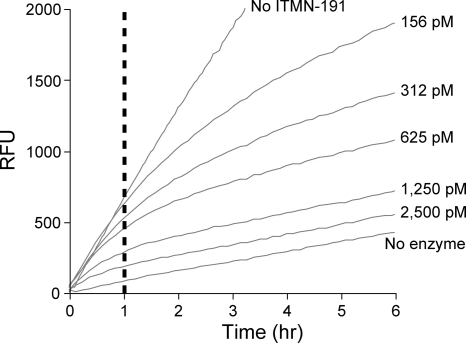 | 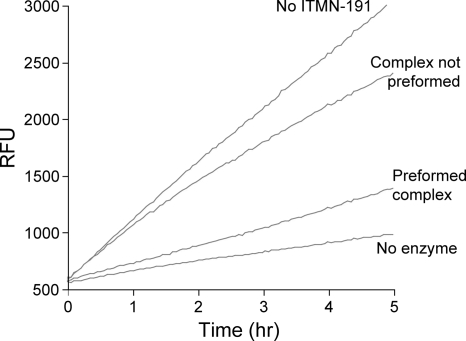 | 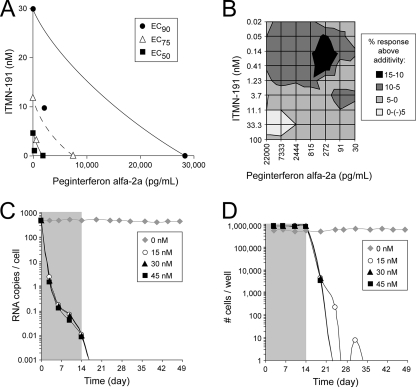 |
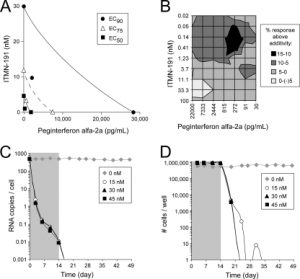 Antiviral activity in combination with peginterferon alfa-2a. Antimicrob Agents Chemother. 2008 Dec;52(12):4432-41. | 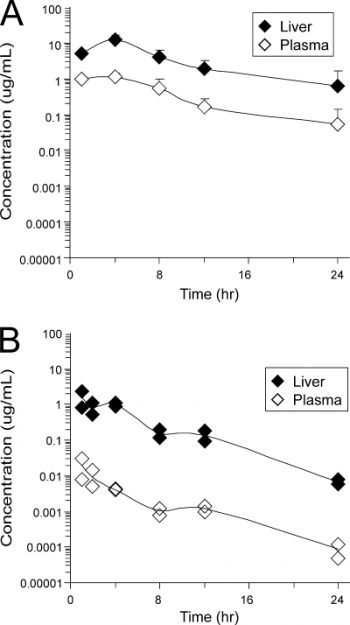 Plasma and liver exposures of ITMN-191. The concentrations of ITMN-191 in liver and plasma were determined by liquid chromatography-tandem mass spectrometry following administration of a single oral dose of 30 mg/kg of ITMN-191 as an aqueous solution. Antimicrob Agents Chemother. 2008 Dec;52(12):4432-41. |
